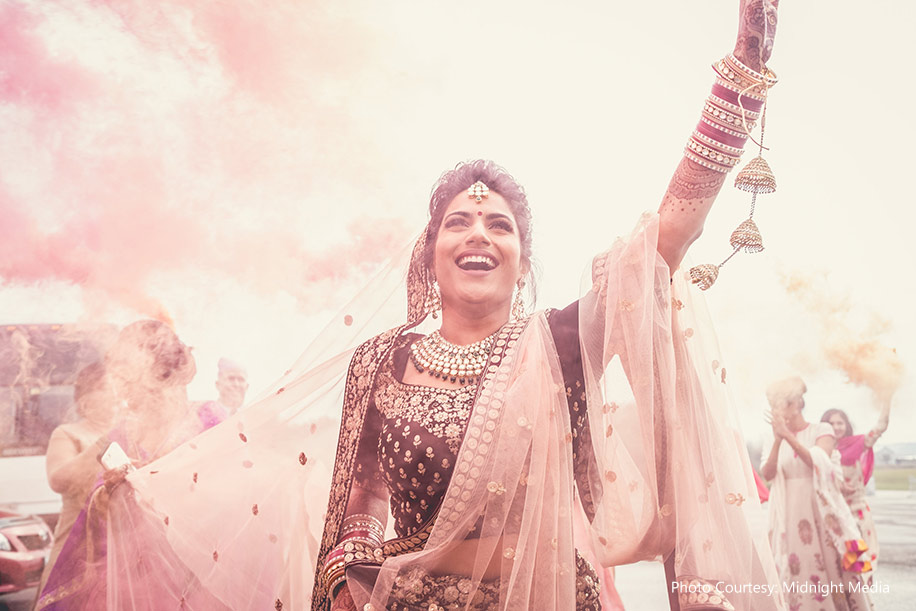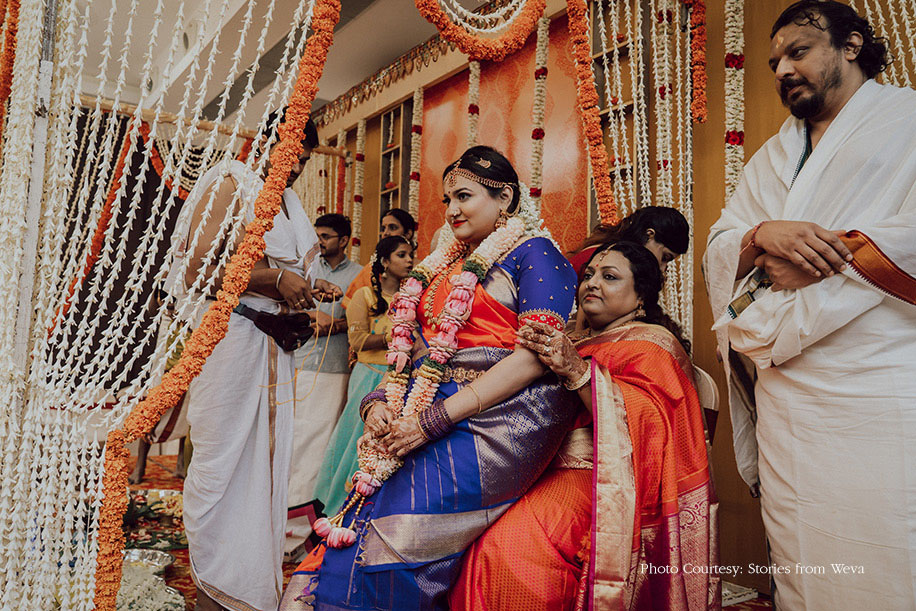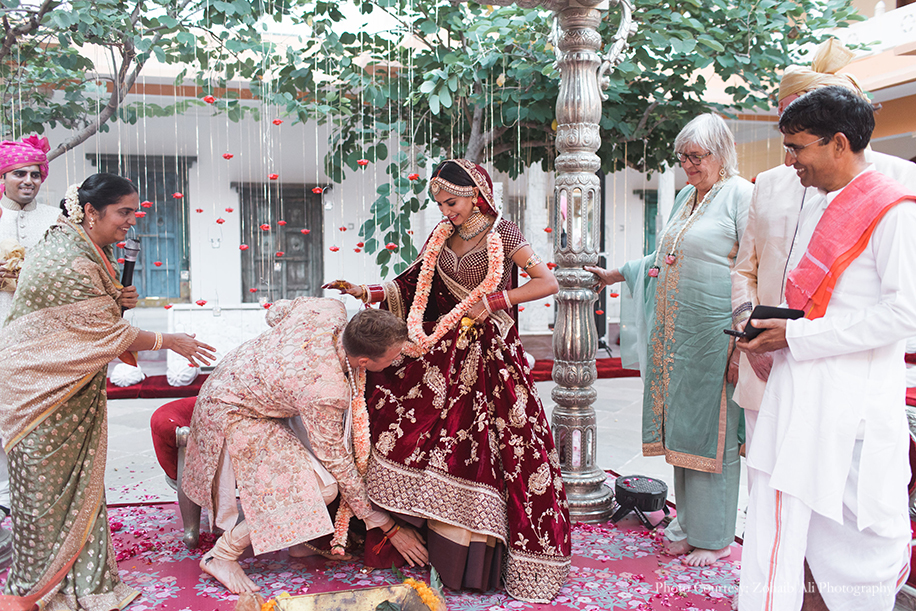Feisty, feminist brides who forged their own traditions
Cloaked in extravagance and cheer, some traditions at weddings are symbols from another less-evolved time, representations of ossified mindsets. While ignorance is bliss, even those who are aware of the ideological significance of some rituals and may not necessarily condone them, still go along with them. It’s too much trouble to rock the boat. Or ‘what will people say’?
They say the hand that rocks the cradle rules the world and these young women, even at their weddings, refused to accept the unacceptable. They shook up some archaic practices and even better, introduced their own versions of the original to bring joy, cheer and yes, the future, to their weddings!

Preethi bent the norm and chose to be given away by her single mother
The ancient Hindu ritual of Kanyadaan has always held a deep-seated patriarchal significance, conferring the right to give a daughter’s hand in marriage, solely to the father. In a ritual that marks the start of a new life for a bride, such a custom greatly diminishes the role of the mother in her life thus far. Preethi, an only child to a single mother, could not imagine being given away by anyone else. In her traditional TamBrahm Chennai wedding to her childhood sweetheart, she honored her mother and all the sacrifices she had made for her through her entire life, by insisting on being given away by her.
She shares, “Going further, we knew we would have a tough time finding a priest who would agree to such a modification to an age-old custom. Traditionally for the ritual, the bride is seated on her father’s lap, and in his absence, the ritual calls for a father-figure male relative. With Brahmin wedding traditions being so staunch, we had to go through several priests before finding someone open-minded enough to perform the altered ritual and we succeeded.. My mother has been there for me every single day of my life, just like thousands of mothers out there. I do hope that they too, get the chance to be an integral force in their child’s wedding instead of being relegated to a superficial stance in the side lines.”

Avanee Kapoor who elucidated that the term ‘partners for life’, starts from the wedding day itself
While attending weddings of friends and family members over the years, Avanee always felt disconnected with many customs and rituals that somehow didn’t relate to her own ethos. The thoughts behind certain rituals felt outdated at best, objectionable at worst, and when the time came for her own wedding, she chose to communicate a massive message with the utmost grace and diplomacy.
She shares, “I’m not a fan of mehndi, so I decided to swap that function for an informal lunch party. There was no chooda ceremony, sindoor, mangalsutra or even pheras. Nor did I feel the need to wear external signs and symbols of marriage to signify being committed and in love, when the same was not expected of my husband. For the ‘Milni’, a function where the men from the bride’s family welcome the men from the groom’s family, we altered it so women were equally involved. Getting everyone on board with our perspective was not easy, but this journey showed me, that finding the one who’ll stand by you and support you through every step makes every challenge in life, a breeze.”

Kari Rao who decided it was time for girls to have some fun
A baraat, for the groom’s family, is the ultimate party – unrestrained dancing, lots of music backed by the excitement of the wedding. On the other hand, the bride is expected to look pretty and be demure. Kari Rao was certainly not the kind to accept such obvious double standards passed off as ‘tradition’. So she planned her very own bridal baraat for her entry into the wedding venue. With her closest friends and family, she put on a show that none of her guests will ever forget. This is a trend that we’re super excited about and can’t wait to see other brides follow her path!
Shubhra Kothari who wasn’t afraid to ask, “What’s in a name?”
“Nothing and everything,” says the bride who decided that she would keep her surname after she got married. Shubhra elaborates, “My surname is a part of my personality. Not only have I identified with it for most of my life, it is also the way my friend, family, and colleagues recognize me. Also you spend so much of your early youth trying to make your parents proud and by my late 20s I felt like I had finally earned my name. So given all of this, it’s frivolous to say that changing your surname isn’t a significant compromise. While you’re building real bonds and ties with your husband and his family, you’ll find that this surname issue becomes inconsequential. Besides, the procedure to have your name and signature changed in official documentation is lengthy, tedious and unnecessary.”
Shubhangi Kothari who refused to be ‘given away’
There’s a bitter edge to the emotional moment of ‘giving away’ your daughter that can be unsettling. In addition to it being reminiscent of donating commodities or livestock, the practice is redundant in the real world for several reasons. Shubhangi explains, “I feel this wedding ritual is wrong at many levels. Let’s start with the idea that you can ‘give’ your loved one away. It devalues the strength of human relations. Furthermore, the fact a girl is treated as a possession and given away as a donation is one of the ultimate examples of patriarchal dogma. To add to the insult, in cases when the mother of the bride is a widow, she isn’t even allowed to be a part of the ritual further reinforcing male dominance. All in all this custom sounded like one I could happily do away with at my pheras.”
Rashmi Iyer who washed away an obsolete practice
In Southern India, a ritual involved the bride’s parents washing the feet of the groom. To some, watching an elderly couple, the same age as the groom’s parents, paying this regressive token of ‘respect’ seems disrespectful in itself. So Rashmi decided it was time to fix this at her nuptials. She tells us of the origins of this practice and why it no longer makes sense, “This tradition dates back to times when roads weren’t made of concrete and the groom, along with his family, would walk to his bride’s village in order to get married to her. Despite that, it does not justify the part where the bride’s father or anyone else except for groom washes his feet for him. In my eyes, this ritual is rather disrespectful of adults and today, with proper roadways, transportation facilities and footwear in place, it holds no meaning.”
Aishwarya Batola who shared the load and doubled the joy
Very often, the bride’s family takes on the financial burden of the wedding or at least a very large portion of it. In some ways, it deprives the bride’s family of the equal status they ought to be able to take for granted. Aishwarya thought about it and tells us what happened. “Once my husband’s parents met mine and it was decided that we were to get married. I made it very clear that both families would split the cost equally and fortunately for me, both, my husband and his parents were supportive of my decision. After all, we all are one family and you never leave any one member alone to lug all the load.” Beautifully said and what a great note to start the union of two families on!
Tanya Fernandes who gave her families the gift of No Gifts
In India, organizing a wedding itself can break the bank but the added costs of gifts can seem superfluous. So Tanya introduced a strict ‘No Gifts’ policy when it was time for her to walk down the aisle. She says, “When you’re getting married, there are too many details that need to be looked into. With so many things happening at the same time, taking care of what presents you must give the other family can feel like you are being asked to stretch yourself. Don’t get me wrong, I am all for showing love by giving gifts. It’s a beautiful gesture that must be done out of one’s free will, not as a mandate. So my husband, our families and I decided that we would not give each other gifts as part of the wedding celebrations. In fact, we went a step ahead and informed our guests that all the gifts that they would give to us would be donated to a local charity.”
Nisha Karlekar who wanted her husband to wear a symbol of marriage too
Some Indian cultures dictate that brides don 7 marks of being a married woman. However, grooms have no such obligation and don’t have to sport even a single symbol of being a married man. Sounds a little lop-sided? Nisha certainly thought so. But she found a way to set things right. She says, “At my wedding, we ditched the sindoor and mangalsutra for an exchange of rings. I don’t need a single one of those marks to remind myself that I am married to the man I love. However, we did exchange rings to signify our love and commitment and the practice does not discriminate based on gender.”
Diipa and Oleg show touching your partner’s feet is more meaningful when it goes both ways
As Indians, we are taught to touch our elders’ feet as a sign of showing respect. While there is nothing wrong with that, things get questionable when at a wedding the bride is asked to touch the groom’s feet while the same is not expected of him. Since marriage is about equal partnership and mutual respect, Diipa Khosla and her husband decided that it was time they bend the traditions a little to make them a lot more gender-equal. Therefore, Oleg touched her feet in order to show that he held her in high regard before she did the same. A small gesture with a deep meaning indeed.

Rachita B who introduced a new way of giving away
Rachita interpreted the tradition of being given away in a unique manner. To her, it was about giving herself wholeheartedly, mind body and spirit, to the one she loves. However, she took the power in her own hands by deciding that this was something that no one but she could do since she was the one who had the first right over herself. “My mom raised me to be an independent, opinionated, and self-sustaining woman by being an example herself. So, despite the fact that I love my mom and family utterly with all my heart, there’s no one in this world who could “give me away” to him – that’s the right I’ve always saved for myself. The decision to get married was ours, as two adults deciding something together. So walking down the aisle alone towards him on our favorite song felt just right – to let him know that I give myself to him honestly, completely, irrevocably, and unconditionally, and walking alone felt like the surest physical way to show that.”
Relate to any of these brides? Let us know which ritual did you unfollow at your wedding at editor@weddingsutra.com.
The post Feisty, feminist brides who forged their own traditions appeared first on WeddingSutra Blog.
from WeddingSutra Blog https://ift.tt/2JNNRM2
https://ift.tt/2UTcGwo



0 comments